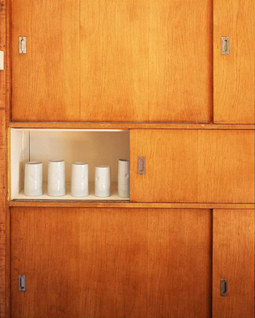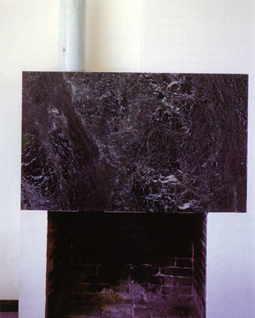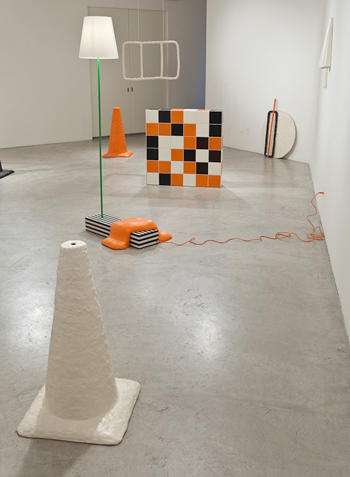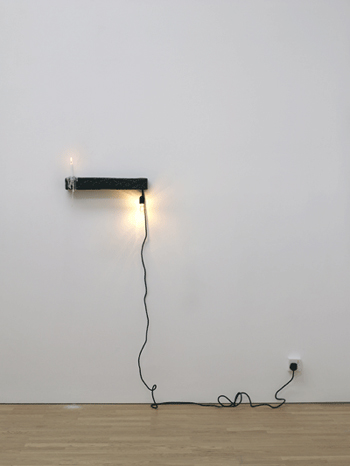Interpreting Ceramics | issue 13 | 2011 Articles & Reviews |
|
|||||||
Museums and the 'Interstices of Domestic Life':Re-articulating Domestic Space in Contemporary Ceramics Practice – continued
Laura Gray |
|
|||||||
|
Edmund de Waal: Interventions in domestic space Edmund de Waal’s invitation to exhibit his work at High Cross House in 1999, led to an architectural intervention, or installation, of a kind that was new for ceramic practice. High Cross House in Devon, completed in 1932, is a modernist house that was built for William Curry, the first headmaster of Dartington Hall School. At the time of de Waal’s project it was open as a visitor attraction, but now is available to rent as a modernist holiday home. The opportunity to engage with the Le Corbusier inspired environment of High Cross House, complete with Bauhaus furniture, allowed de Waal to extend ideas that were already present in his ‘cargo’ works – groupings, repetition, concealment and revelation. De Waal began to make work that he called cargoes in order to question the assumption that it was not possible to be a serious contemporary artist and make pots.16 He called these groups of pots cargoes to emphasize the fact that they were groups, they were multiples - not just the single pot - but also that they were in transit in some kind of way between different cultures – between East and West, but also between art and craft, between sculpture and ceramics. Part of his experimentation with the cargo works was to start putting them in interesting and diverse places, trying to work out why groups of vessels, groups of pots had particular kinds of energy or resonance when they were in particular places. De Waal has said that he was really just trying to experiment with the life of pots, and this idea took hold so that his practice became about making things for places:
The installation at High Cross House was the beginning of this manner of working, which has become so central to de Waal’s artistic practice. Instead of using High Cross House as an attractive modernist backdrop for his work, De Waal became interested in using the house as a whole, less as an unusual exhibition space, but as a collaborative element with the porcelain. It is this collaboration between domestic space and the vessels that draws out the sculptural qualities, the ability to make references beyond form and material. In the kitchen, an open cupboard reveals a line of porcelain vessels. A single tall, lidded jar sits on the fireplace in the living room.
These are pots, with the suggestions of utility and function that we could expect to find with pots, and though they are being encountered in what was once a home, they assert themselves as works of art through their placement, through their dialogue with the calm modernism of the architecture of the house. In 1999, around the time of the project at High Cross, de Waal was interviewed for an article in the journal Ceramics Art and Perception. He is quoted as saying, ‘the whole lazy approach to how ceramics are used, displayed and revealed within our cultural spaces is an important issue that has to be addressed’.19 With the project at High Cross House, de Waal was taking up this concern directly, and display and revelation still persist as strands of thought in his most recent works that make use of closed doors and opaque glass. At High Cross house, a domestic space transformed into a museum (and back again), ideas of privacy and display, private and public, could be tested through the placement of pots. De Waal, writing about his intervention at the house describes how, ‘thinking through where to make pots for in the house made me think about the key places and interstices of domestic life and how these areas change when a house becomes a museum’.20 De Waal’s installation also challenges the modernist separation of home and art, which persists in the idea of the white cube as the ideal space in which to show art, and the modernist desire to see distinction between categories of art. De Waal continued his concern with the aesthetic of display eight years later with an exhibition held across two galleries. Beginning at Kettle’s Yard, the exhibition then moved to mima, where the same works adapted to the very different spaces of the then newly opened gallery. De Waal’s relationship with Kettle’s Yard was already established and long standing at the time the installation took place, having spent time at the house during his time as a student at Cambridge, ‘even when I was reading English I was making pots, and spending time in Kettle's Yard looking at pots and looking at paintings, and the two things really went hand in hand’.21 The home of Jim and Helen Ede from 1958-1973, Kettle’s Yard is another example of a space that has been by turns domestic and public. The house was conceived with the students of Cambridge in mind, and the Ede’s open house policy meant that students were able to come to the house and view the collection Jim Ede had created during his time as a curator at Tate during the 1920s and 1930s. In 1966 the house and contents were given to Cambridge University and its role as a gallery was formalised, though the character the Edes brought to the house was retained.22 Mima took some of the pieces that were made very specifically for the house at Kettle’s Yard such as A Reading Silence which was a group of pots placed in a bookcase. What de Waal had done was to remove his favourite books, books that he would read when he was a student at Cambridge and used to visit Kettle’s Yard. The books he removed he replaced with his pots. James Beighton discussed the challenges of curating a work made specifically for another space:
For Beighton, modernism was a central aspect of the relationship between the two spaces. Kettle’s Yard:
Anders Ruhwald: Bringing the domestic into the white cube Ceramics has been moving out of craft galleries into white cube spaces for at least three decades (Fast Forward at the ICA in 1985, The Raw and the Cooked at Modern Art Oxford in 1993, the inclusion of ceramics at Tate St Ives as reported in ‘Ceramics at the Tate’, Ceramic Review no. 144, 1993). The presence of ceramics in white cube spaces, which are more usually designated for the display of ‘fine’ art, was part of the repositioning of ceramics as a medium with sculptural potential that The Raw and the Cooked aimed for. Anders Ruhwald, while choosing to show his work in conventional contemporary art white cube environments (Lemberg Gallery, Detroit; Gregory Lind Gallery, San Fransisco; Drud & Køppe Gallery, Copenhagen) elects to disrupt the crisp, serious aesthetic by introducing domestic touches such as ribbon curtains, carpets, and visible plug sockets into these spaces. Ruhwald considers that, ‘the implication of a domestic setting thus activates a situation that potentially opens up a reading of the work where we engage with the objects at a one-to-one level’.25 Finding the relationship between audience and sculpture limiting, Ruhwald prefers instead to encourage interaction on a material and practical level, which he does through reference to familiar, functional objects.
Ruhwald writes of his frustration with the earlier conventional display of his work in the exhibition Keramiske Veje (Copenhagen, 2004), ‘the objects existed in the gallery space as traditional sculptural objects…People could observe them, but there would be no interaction at the material or practical level’.26 Ruhwald echoes de Waal’s frustrations with the limitations of display. Perhaps of particular interest is Ruhwald’s belief that the sculptural form and presentation of his work closed down rather than expanded dialogue with the viewer. Raised up on a continuous high plinth, and mounted on the wall, the objects in this exhibition are held apart from the viewer by the manner of their presentation. In contrast, the references to the domestic, both by setting, arrangement and the objects themselves that Ruhwald makes in his later exhibitions such as You Will See (Lemberg Gallery, Detroit, USA, 2010-11) and We float in space and cannot perceive the new order (Miyako Yoshinaga Art Prospects, New York, USA, 2007) place the viewer and the object in the same space, sharing the same ground. Ruhwald explains his relationship with the domestic in an article in issue nine of Interpreting Ceramics, ‘I am interested in working with the ‘thingness’ of the ceramic object. My sculptures mediate the domestic sphere-not as the actual everyday item, but as a commentary on that item’.27 Ruhwald explores the complex relationship between material and form that is at the heart of testing whether vessels can be understood as sculpture, or as having a meaningful relationship with sculpture. Ruhwald came to the field by making pottery, developing an understanding of ‘the potential of using functional forms to mediate concerns that lie outside the confines of pure utility’.28 For Ruhwald the term kunsthåndværk (literally art-craft) is defined by a studio practice that generates carefully laboured objects formally linked to objects of utility but rarely fulfilling that role practically.
Beighton found the unconcealed plug sockets and cables trailing drawing-like down the wall, as simultaneously ‘decorative and uncomfortable’ in the gallery space. Decorative because the gallery had hidden plug sockets and cables that could have been used to power Candle/Light. The ugly, awkward plug sockets were unnecessary ornamentation, wanted only for the look that they could bring to the space, and the atmosphere they could confer on the pristine gallery.
Beighton considered that, ‘the work was trying its hardest to upset the space’. With the use of gold foil Ruhwald ‘was interested in referencing the Wiener Werkstätte particularly, so the repetition of that grid structure looks back to Josef Hoffmann’s designs. But the use of gold also talks about Klimt and his use of gold leaf on his canvases’.30 Ruhwald also used ribbon curtains to divide spaces, ‘the back gallery was carpeted with ribbon curtains dividing it in two. So Anders is recognising there that they are anything but neutral spaces and I think most of our artists have recognised that they are anything but neutral spaces’.31 Conclusion Christopher Reed has demonstrated that for the European modernists, ‘being undomestic came to serve as a guarantee of being art’.32 As a result the domestic became a site of subversion, ‘a staging ground for rebellion’.33 If modernism suppressed a serious engagement with domesticity, some artists returned with a vengeance to the domestic as a field of enquiry during the shifts in art and design signified by the term ‘post-modernism’.34 This view is supported by the engagement of artists such as Louise Bourgeois and Mona Hatoum with ideas surrounding the home and domesticity, which they have unsettled and destabilised in their work.35 While Ruhwald, Twomey and de Waal have not been attempting a destabilization of the idea of the home, they have been conducting their own quiet rebellion. The rebellion that they have staged in the house museum and in the exploration of ceramics in relation to the concept of ‘the domestic’ has been to continue to push the notion of clay as a transgressive material, a valid material for art, as well as craft. Acknowledgments I would like to thank Dr Jeffrey Jones, Dr Matthew Partington and Prof. Moira Vincentelli for their help and support with the development of this article. I would like to thank James Beighton, curator at mima (Middlesbrough Institute of Modern Art), Amy Dickson, assistant curator at Tate Modern, and Clare Twomey for so generously giving their time to assist with this research. Thanks are due to the editorial team of Interpreting Ceramics for their assistance and insight. Finally, I would like to thank Anders Ruhwald, Clare Twomey and Edmund de Waal for permission to use images of their work. Top of the page | Download Word document | Next Notes To return to the article click the relevant note number 16 Edmund de Waal, ‘Edmund de Waal Part 1: On Location’, transcript of an interview conducted for the V&A, available at http://www.vam.ac.uk/channel/people/ceramics/ 17 de Waal, ‘Edmund de Waal Part 1: On Location’, accessed 15.02.2011). 18 Michael Tooby, ‘Edmund de Waal’s Work in Progress’, in E. de Waal, E., and M. Tooby, Modern Home: An intervention by Edmund de Waal at High Cross House, Totnes, Dartington Hall Trust, 1999, p.20. 19 As cited in Jeffrey Jones, Studio Pottery in Britain 1900-2005, London, A & C Black, 2007, p.234. 20 Edmund de Waal, ‘Making Some Pots for High Cross House’ in Modern Home: An intervention by Edmund de Waal at High Cross House, Totnes, Dartington Hall Trust, 1999, p.7. 21 Edmund de Waal interviewed by John Tusa for BBC Radio 3 http://www.bbc.co.uk/radio3/johntusainterview/dewaal_transcript.shtml (accessed 15.02.2011). 22 http://www.kettlesyard.co.uk/house/index.html (accessed 17.06.2011) 23 Author’s interview with James Beighton, curator at mima, 2010. 24 Ibid. 25 Anders Ruhwald, ‘Functional Languages’, Interpreting Ceramics, no.9, http://www.interpretingceramics.com/issue009/articles/04.htm (accessed 14.02.2011), unpaginated. 26 Ibid. 27 Ibid. 28 Ibid. 29 Interview with James Beighton, 2010. 30 Ibid. 31 Ibid. 32 Reed, ‘Introduction’, in Not at Home’, p.16. 33 Ibid. 34 Reed, ‘Domestic Disturbances’, p.43. 35 Perry, ‘Dream Houses: installations and the home’, p.256. |
||||||||
© The copyright of all the images in this article rests with the author unless otherwise stated |
||||||||
Museums and the 'Interstices of Domestic Life' • Issue 13 |




